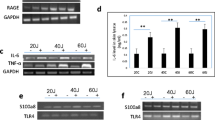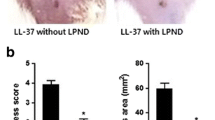Abstract
Our aim was to investigate the effects of intense pulsed light (IPL) on collagen expression in BALB/c mouse skin and confirm its relative molecular mechanisms. The dorsal skin of BALB/c mice was irradiated by IPL. Before treatment and from 1 day to 8 weeks (1 day, 3 days, 5 days, 1 week, 2 weeks, 3 weeks, 4 weeks, 6 weeks and 8 weeks) after treatment, the irradiated skin specimens were examined. The histology showed dermis thickening, accompanied with increased collagen and better organization. After IPL irradiation from 2 W up to 8 W, the staining of collagen types I and III in the IPL-treated groups was stronger than in the sham groups (P < 0.05), and the mRNA expression levels of the procollagen types I and III had also increased (P < 0.05). The up-regulation effects of IPL irradiation were time-dependent. The mRNA expression levels of matrix metalloproteinase (MMP)-1 and MMP-2 decreased progressively after IPL irradiation at 2 W up to 8 W (P < 0.05), and this down-regulation effect of IPL was also time-dependent. However, the mRNA expression of vascular endothelial growth factor (VEGF) had shown no obvious change by the end of the experiment (P > 0.05). Taking these factors together, we can conclude that IPL irradiation can not only enhance new collagen production, but also decrease collagen degradation in photorejuvenation mechanisms in mouse skin.




Similar content being viewed by others
References
Berneburg M, Plettenberg H, Krutmann J (2000) Photoaging of human skin. Photodermatol Photoimmunol Photomed 16:239–244
Ohnishi Y, Tajima S, Akiyama M (2000) Expression of elastin-related proteins and matrix metalloproteinases in actinic elastosis of sun-damaged skin. Arch Dermatol Res 292:27–31
Ouchi N, Shibata R, Walsh K (2005) AMP-activated protein kinase signaling stimulates VEGF expression and angiogenesis in skeletal muscle. Circ Res 96:838–846
Bitter PH (2000) Noninvasive rejuvenation of photodamaged skin using serial, full-face intense pulsed light treatments. Dermatol Surg 26:835–842
Goldman MP, Weiss RA, Weiss MA (2005) Intense pulsed light as a nonablative approach to photoaging. Dermatol Surg 31:1179–1187
Negishi K, Tezuka Y, Kushikata N (2001) Photorejuvenation for Asian skin by intense pulsed light. Dermatol Surg 27:627–631
Fodor L, Peled IJ, Rissin Y (2004) Using intense pulsed light for cosmetic purposes: our experience. Plast Reconstr Surg 113:1789
Acarturk TO (2003) Treatment of the vascular lesions of the face and neck using selective vascular photothermolysis with intense pulse light. Eur J Plast Surg 26:319–323
Talwar HS, Grilfiths CEM, Fisher GJ (1995) Reduced type I and type III procollagen in photodamaged skin. J Invest Dermatol 105:285–290
Iyer S, Carranza D, Kolodney M (2007) Evaluation of procollagen I deposition after intense pulsed light treatments at varying parameters in a porcine model. J Cosmet Laser Ther 9:75–78
Goldberg DJ (2000) New collagen formation after dermal remodeling with an intense pulsed light source. J Cutan Laser Ther 2:59–61
Chan HH, Yang CH, Leung JC (2007) An animal study of the effects on p16 and PCNA expression of repeated treatment with high-energy laser and intense pulsed light exposure. Lasers Surg Med 39:8–13
Bramono DS, Richmond JC, Weitzel PP (2004) Matrix metalloproteinases and their clinical applications in orthopaedics. Clin Orthop Relat Res 428:272–285
Hornebeck W (2003) Down-regulation of tissue inhibitor of matrix metalloprotease-1 (TIMP-1) in aged human skin contributes to matrix degradation and impaired cell growth and survival. Pathol Biol (Paris) 51:569–573
Gale NW (1999) Growth factors acting via endothelial cell-specific receptor tyrosine kinases: VEGFs, angiopoietins, and ephrins in vascular development. Genes Dev 13:1055–1066
Author information
Authors and Affiliations
Corresponding author
Rights and permissions
About this article
Cite this article
Luo, D., Cao, Y., Wu, D. et al. Impact of intense pulse light irradiation on BALB/c mouse skin—in vivo study on collagens, matrix metalloproteinases and vascular endothelial growth factor. Lasers Med Sci 24, 101–108 (2009). https://doi.org/10.1007/s10103-007-0529-8
Received:
Accepted:
Published:
Issue Date:
DOI: https://doi.org/10.1007/s10103-007-0529-8




